Study on Performance of the Thermoelectric Cooling Device with Novel Subchannel Finned Heat Sink
Abstract
:1. Introduction
2. Materials and Methods
2.1. TEC Model
2.2. Heat Sink Model
2.3. Experiments
3. Results and Discussions
3.1. Basic Thermal Performance of Heat Sink Comparison
3.2. Thermal Performance under Different Current of Heat Sink Comparison
3.3. Thermal Performance under Different Wind Speed of Heat Sink Comparison
3.4. Additional Power of Thermoelectric Devices Comparison
4. Conclusions
- The new finned heat sink has a stronger heat dissipation function than the conventional finned heat sink and its thermal resistance is reduced by 42.6%.
- The thermoelectric refrigeration system using the new fin heat sink has a higher coefficient of refrigeration performance, and the COP of the thermoelectric refrigeration system under the new fin can be increased by 22.8%.
- Cooling wind speed can further improve the refrigeration performance, and increasing the wind speed can make the lowest temperature of the refrigeration performance reach −8.25 °C.
- The additional power consumed by the fan of the thermoelectric refrigeration system under the new finned radiator can be up to 166% compared with the conventional refrigeration device.
Author Contributions
Funding
Institutional Review Board Statement
Informed Consent Statement
Data Availability Statement
Conflicts of Interest
Abbreviations
| COP | coefficient of performance |
| fin base thickness, mm | |
| fin spacing, mm | |
| sub-fin and fin spacing 1, mm | |
| sub-fin and fin spacing 2, mm | |
| sub-fin and fin spacing 3, mm | |
| sub-fin thickness, mm | |
| sub-fin length 1, mm | |
| sub-fin length 2, mm | |
| fin thickness, mm | |
| height of heat sink, mm | |
| electrical current, A | |
| length of heat sink, mm | |
| TEC input electrical power, W | |
| FAN input electrical power, W | |
| cooling capacity of TEC, W | |
| heat generation of TEC, W | |
| thermal resistance, ◦C/W | |
| electrical resistance of TEC, Ω | |
| thermal conductivity of TEC, W/m K | |
| Seebeck coefficient of TEC, V/K | |
| temperature, °C | |
| ambient temperature, °C | |
| TEC module cold side temperature, °C | |
| TEC hot side temperature in supplier’s datasheet, °C | |
| plate temperature, °C | |
| TEC module hot side temperature, °C | |
| thermoelectric cooler | |
| cooling wind speed, m/s | |
| voltage, V | |
| width of heat sink, mm | |
| Greece symbols | |
| maximum temperature difference between hot and cold ends of TEC module, °C | |
| Subscripts | |
| ambient | |
| cold side | |
| fan | |
| hot side | |
| maximum | |
| plate | |
| tec |
References
- Choudhary, V.; Kumar, M.; Patil, A.K. Experimental investigation of enhanced performance of pin fin heat sink with wings. Appl. Therm. Eng. 2019, 155, 546–562. [Google Scholar] [CrossRef]
- Goswami, R.; Das, R. Waste heat recovery from a biomass heat engine for thermoelectric power generation using two-phase thermosyphons. Renew. Energy 2020, 148, 1280–1291. [Google Scholar] [CrossRef]
- Sharma, S.; Dwivedi, V.K.; Pandit, S.N. A review of thermoelectric devices for cooling applications. Int. J. Green Energy 2014, 11, 899–909. [Google Scholar] [CrossRef]
- Huang, Y.X.; Wang, X.D.; Cheng, C.H.; Lin, D.T.W. Geometry optimization of thermoelectric coolers using simplified conjugate-gradient method. Energy 2013, 59, 689–697. [Google Scholar] [CrossRef]
- Fabián-Mijangos, A.; Min, G.; Alvarez-Quintana, J. Enhanced performance thermoelectric module having asymmetrical legs. Energy Convers. Manag. 2017, 148, 1372–1381. [Google Scholar] [CrossRef]
- Dongxu, J.; Zhongbao, W.; Pou, J.; Mazzoni, S.; Rajoo, S.; Romagnoli, A. Geometry optimization of thermoelectric modules: Simulation and experimental study. Energy Convers. Manag. 2019, 195, 236–243. [Google Scholar] [CrossRef]
- Lu, X.; Zhao, D.; Ma, T.; Wang, Q.; Fan, J.; Yang, R. Thermal resistance matching for thermoelectric cooling systems. Energy Convers. Manag. 2018, 169, 186–193. [Google Scholar] [CrossRef]
- He, Y.; Cao, C.; Wu, J.; Chen, G. Investigations on coupling between performance and external operational conditons for a simiconductor refrigeration system. Int. J. Refrig. 2020, 109, 172–179. [Google Scholar] [CrossRef]
- Elghool, A.; Basrawi, F.; Ibrahim, T.K.; Habib, K.; Ibrahim, H.; Idris, D.M.N.D. A review on heat sink for thermo-electric power generation: Classifications and parameters affecting performance. Energy Convers. Manag. 2017, 134, 260–277. [Google Scholar] [CrossRef]
- Liu, Y.; Su, Y. Experimental investigations on COPs of thermoelectric module frosting systems with various hot side cooling methods. Appl. Therm. Eng. 2018, 144, 747–756. [Google Scholar] [CrossRef]
- Riffat, S.B.; Qiu, G.Q. Design and characterization of a cylindrical, water-cooled heat sink for thermoelectric air-conditioners. Int. J. Energy Res. 2006, 30, 67–80. [Google Scholar] [CrossRef]
- Astrain, D.; Vián, J.G.; Domínguez, M. Increase of COP in the thermoelectric refrigeration by the optimization of heat dissipation. Appl. Therm. Eng. 2003, 23, 2183–2200. [Google Scholar] [CrossRef] [Green Version]
- Astrain, D.; Vián, J.G. Study and optimization of the heat dissipater of a thermoelectric refrigerator. J. Enhanc. Heat Transf. 2005, 12, 159–170. [Google Scholar] [CrossRef]
- Karwa, N.; Stanley, C.; Intwala, H.; Rosengarten, G. Development of a low thermal resistance water jet cooled heat sink for thermoelectric refrigerators. Appl. Therm. Eng. 2017, 111, 1596–1602. [Google Scholar] [CrossRef]
- Cuce, E.; Guclu, T.; Cuce, P.M. Improving thermal performance of thermoelectric coolers (TECs) through a nanofluid driven water to air heat exchanger design: An experimental research. Energy Convers. Manag. 2020, 214, 112893. [Google Scholar] [CrossRef]
- Kim, D.K.; Kim, S.J.; Bae, J.K. Comparison of thermal performances of plate-fin and pin-fin heat sinks subject to an impinging flow. Int. J. Heat Mass Transf. 2009, 52, 3510–3517. [Google Scholar] [CrossRef]
- Izci, T.; Koz, M.; Koşar, A. The effect of micro pin-fin shape on thermal and hydraulic performance of micro pin-fin heat sinks. Heat Transf. Eng. 2015, 36, 1447–1457. [Google Scholar] [CrossRef]
- Wiriyasart, S.; Naphon, P. Heat spreading of liquid jet impingement cooling of cold plate heat sink with different fin shapes. Case Stud. Therm. Eng. 2020, 20, 100638. [Google Scholar] [CrossRef]
- Rao, A.K.; Somkuwar, V. Heat transfer of a tapered fin heat sink under natural convection. Mater. Today Proc. 2021, 46, 7886–7891. [Google Scholar] [CrossRef]
- Lee, G.; Lee, I.; Kim, S.J. Topology optimization of a heat sink with an axially uniform cross-section cooled by forced convection. Int. J. Heat Mass Transf. 2020, 168, 120732. [Google Scholar] [CrossRef]
- Abbas, A.; Wang, C.C. Augmentation of natural convection heat sink via using displacement design. Int. J. Heat Mass Transf. 2020, 154, 119757. [Google Scholar] [CrossRef]
- Leong, K.C.; Li, H.Y.; Jin, L.W.; Chai, J.C. Numerical and experimental study of forced convection in graphite foams of different configurations. Appl. Therm. Eng. 2010, 30, 520–532. [Google Scholar] [CrossRef]
- Hong, F.; Cheng, P. Three dimensional numerical analyses and optimization of offset strip-fin microchannel heat sinks. Int. Commun. Heat Mass Transf. 2009, 36, 651–656. [Google Scholar] [CrossRef]
- Zhang, H.Y.; Mui, Y.C.; Tarin, M. Analysis of thermoelectric cooler performance for high power electronic packages. Appl. Therm. Eng. 2010, 30, 561–568. [Google Scholar] [CrossRef]
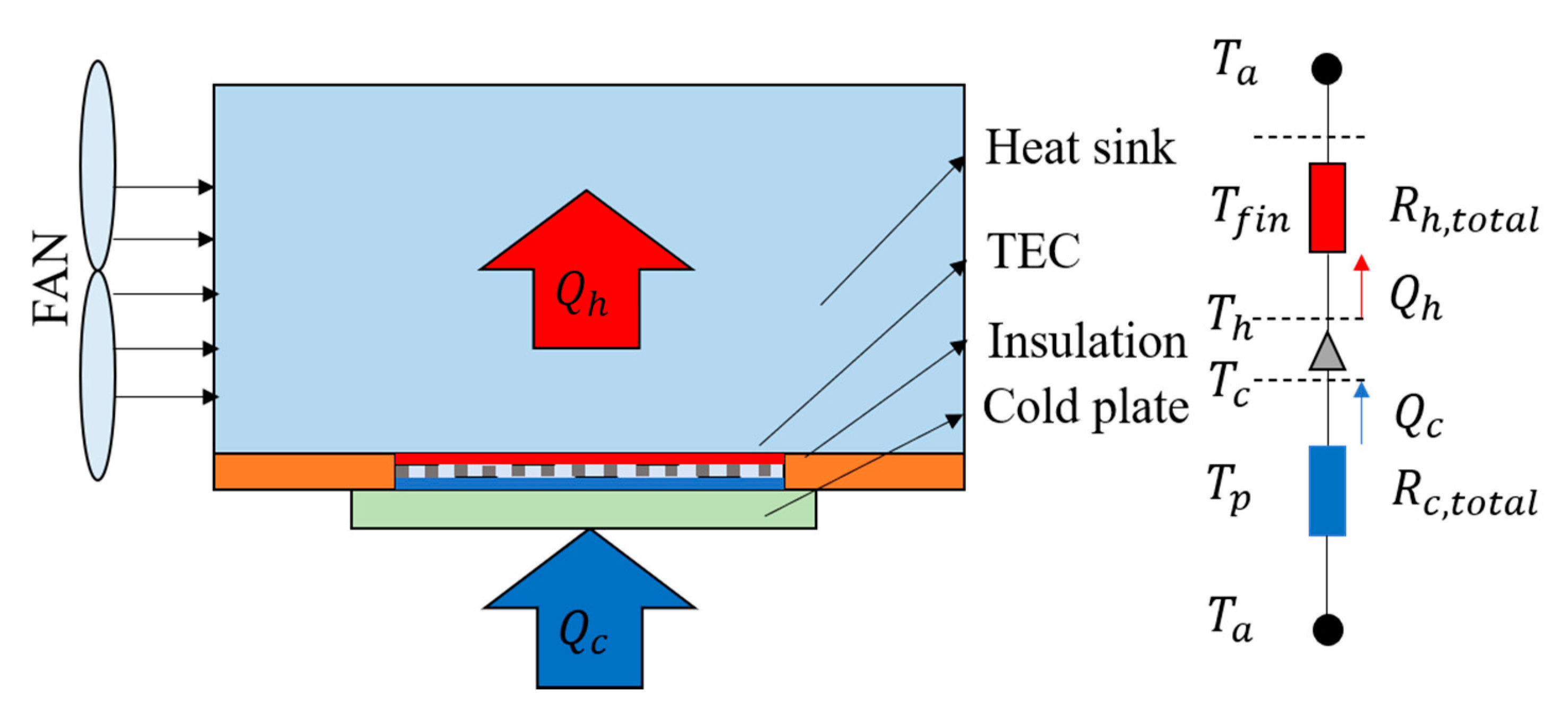
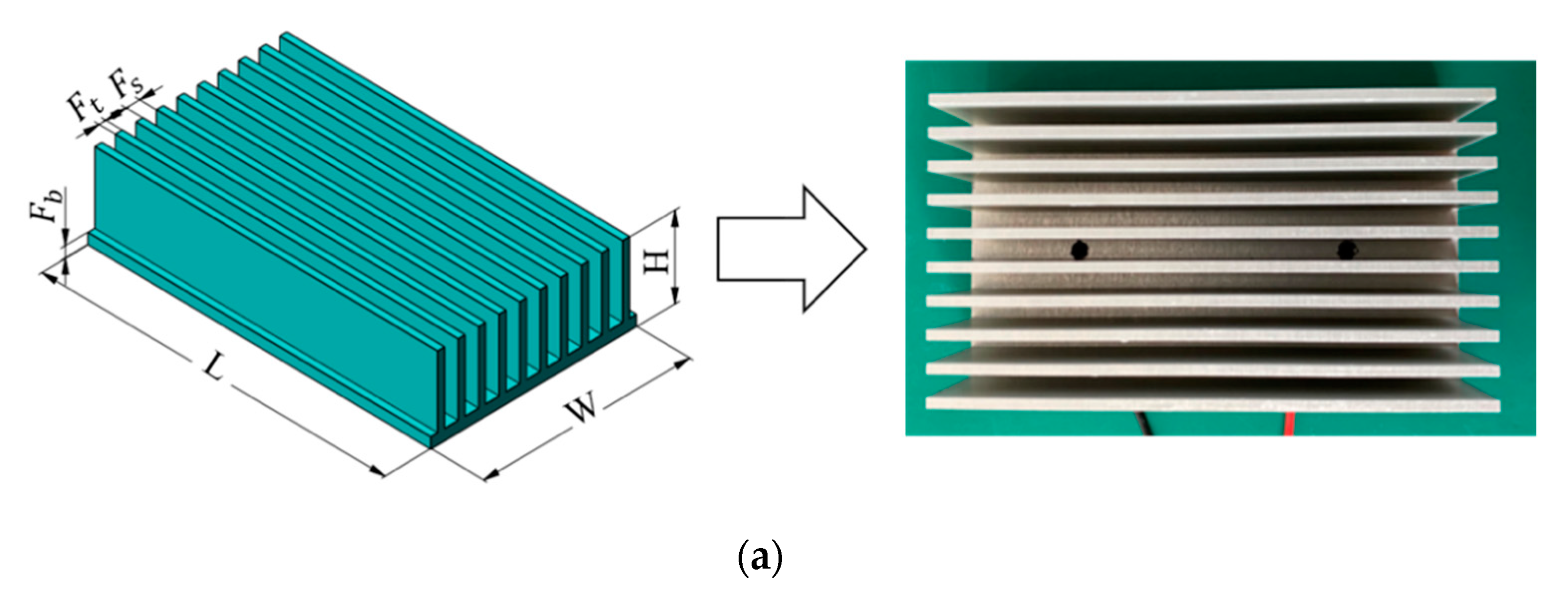
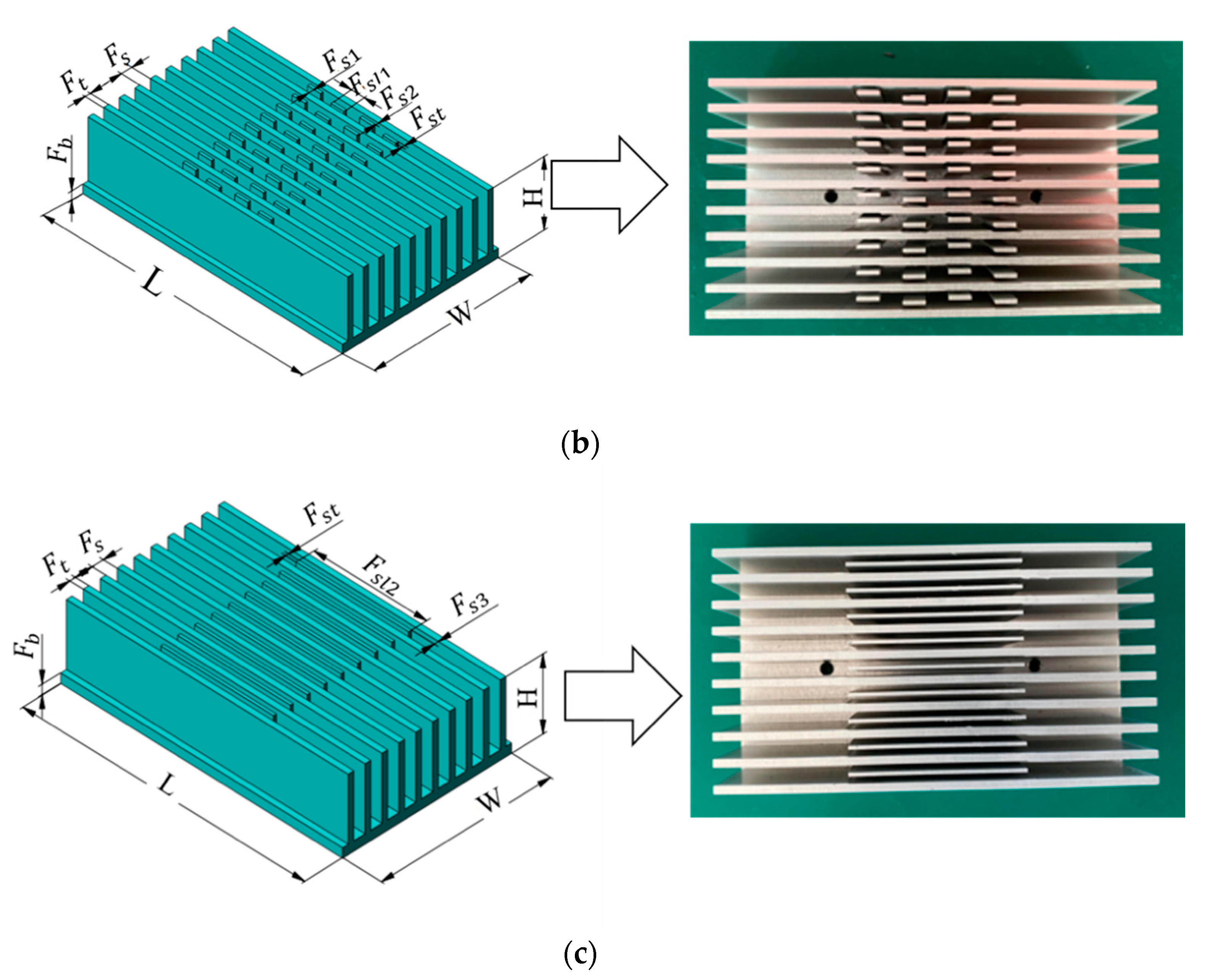
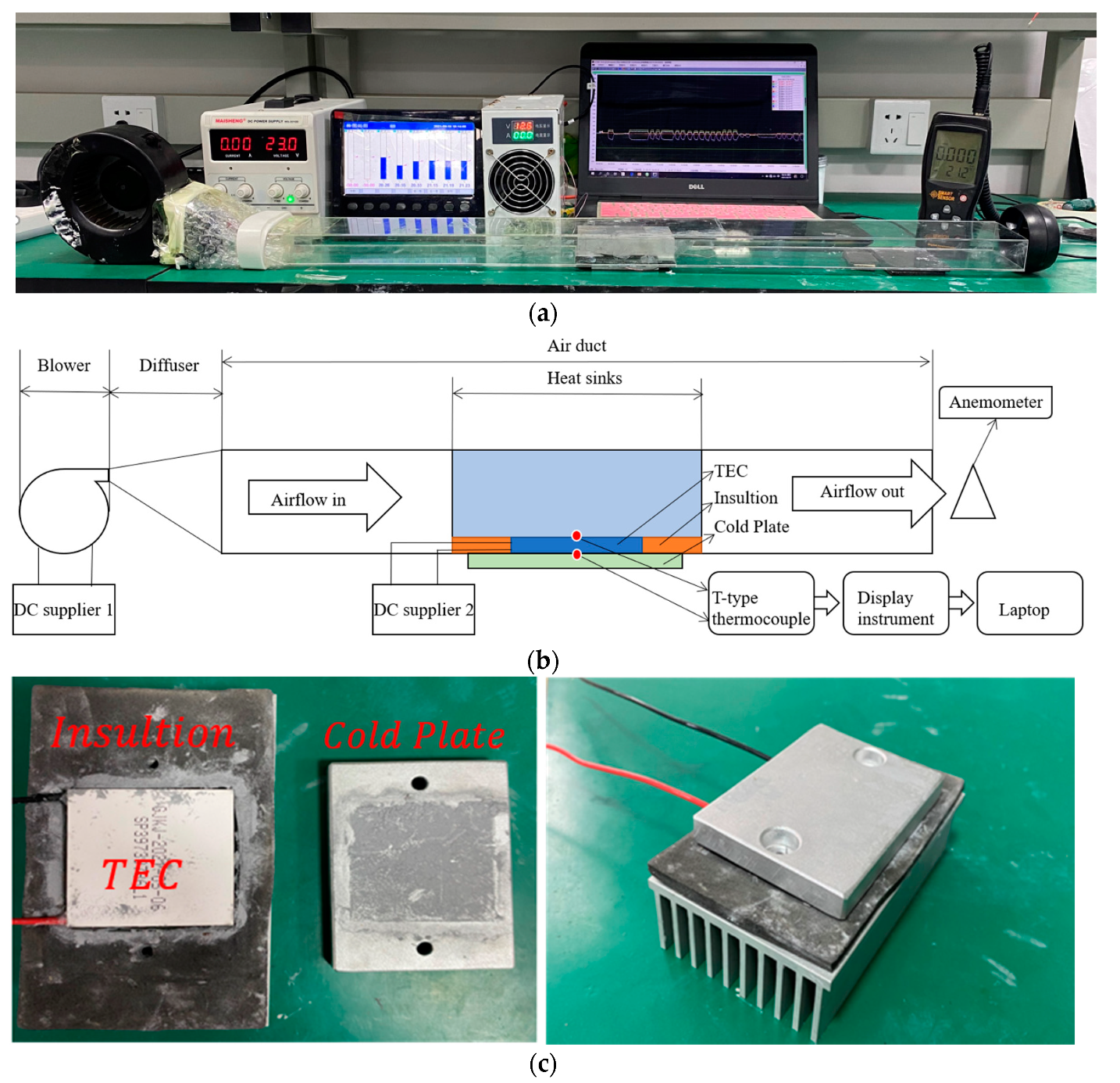
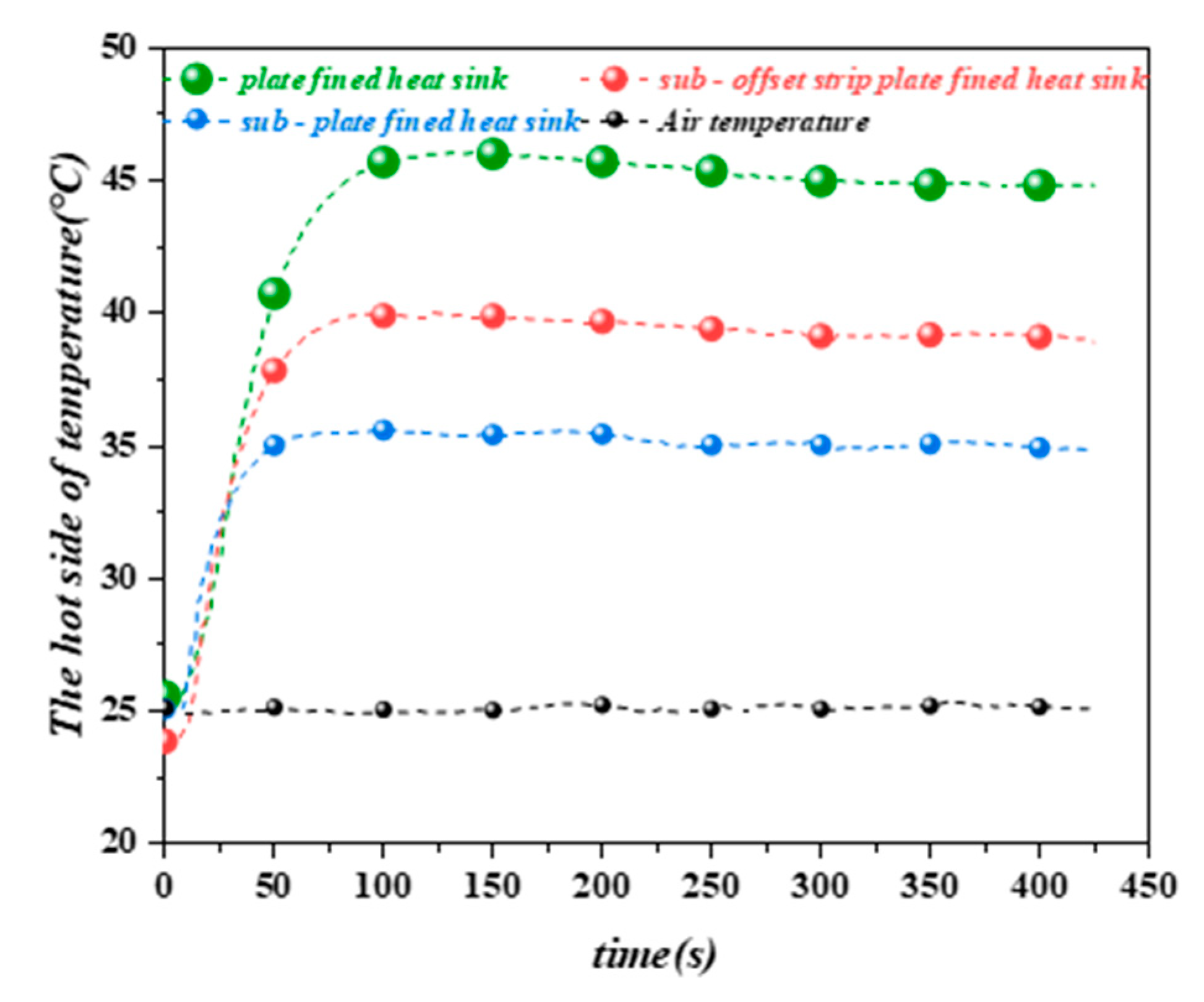
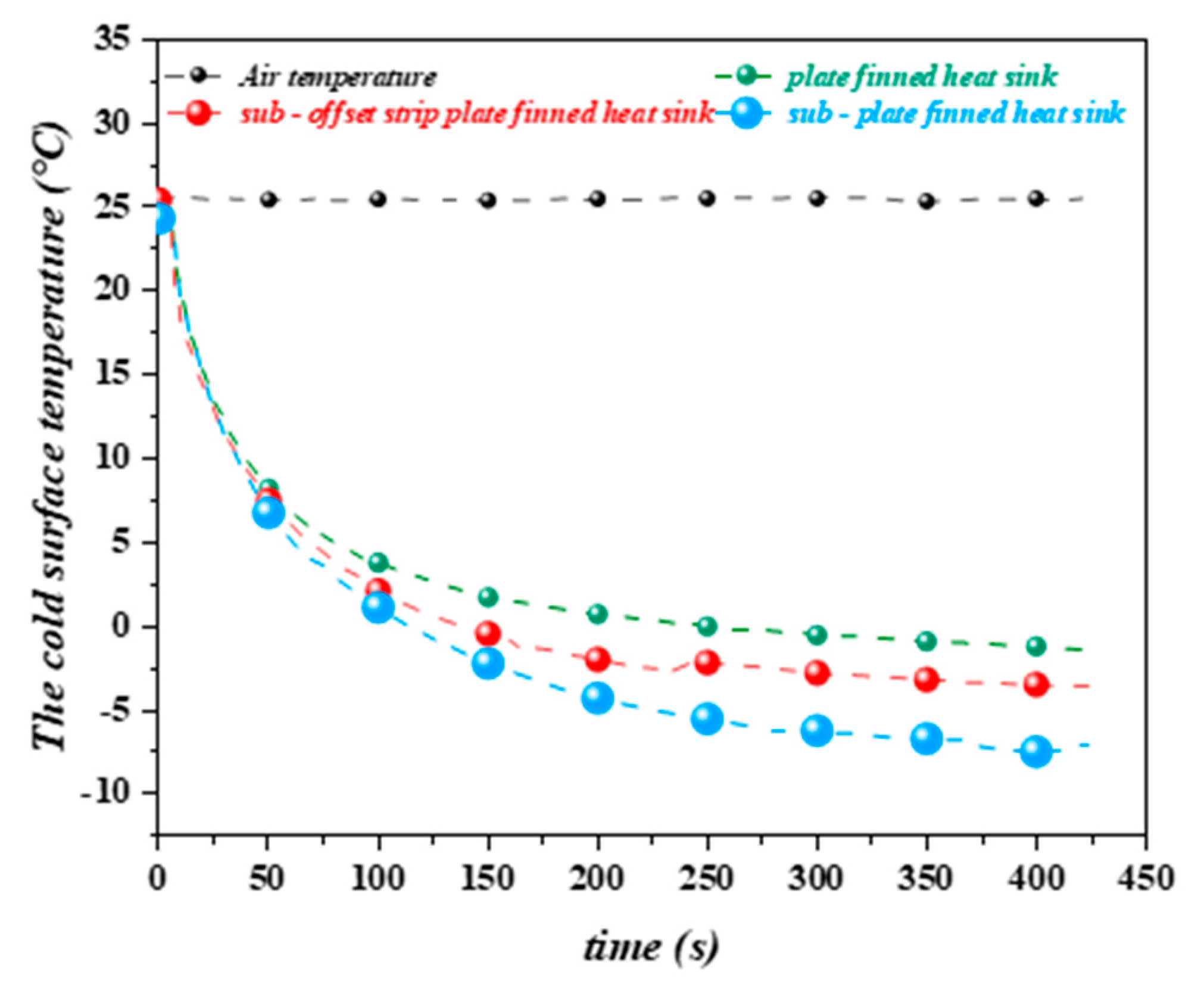
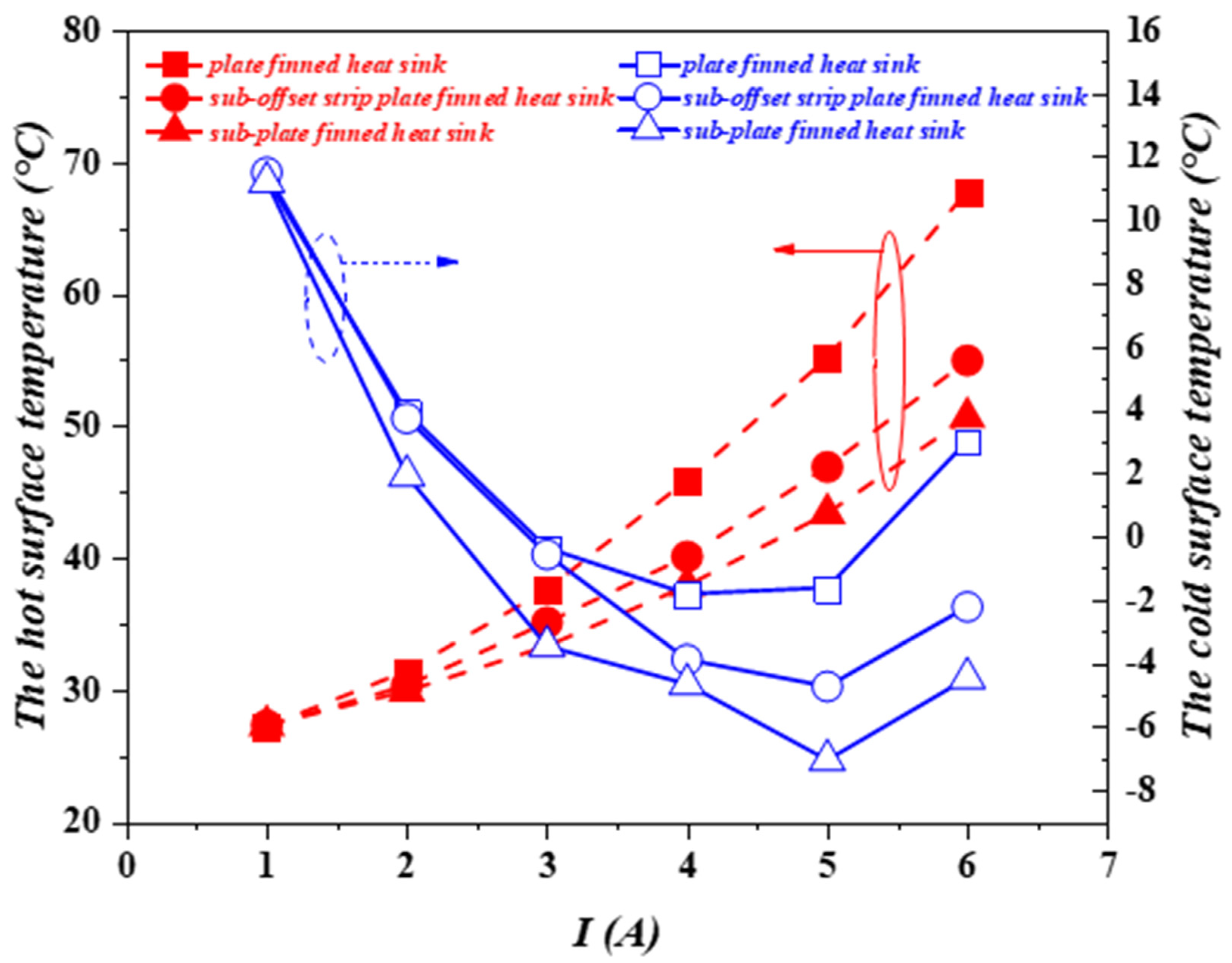
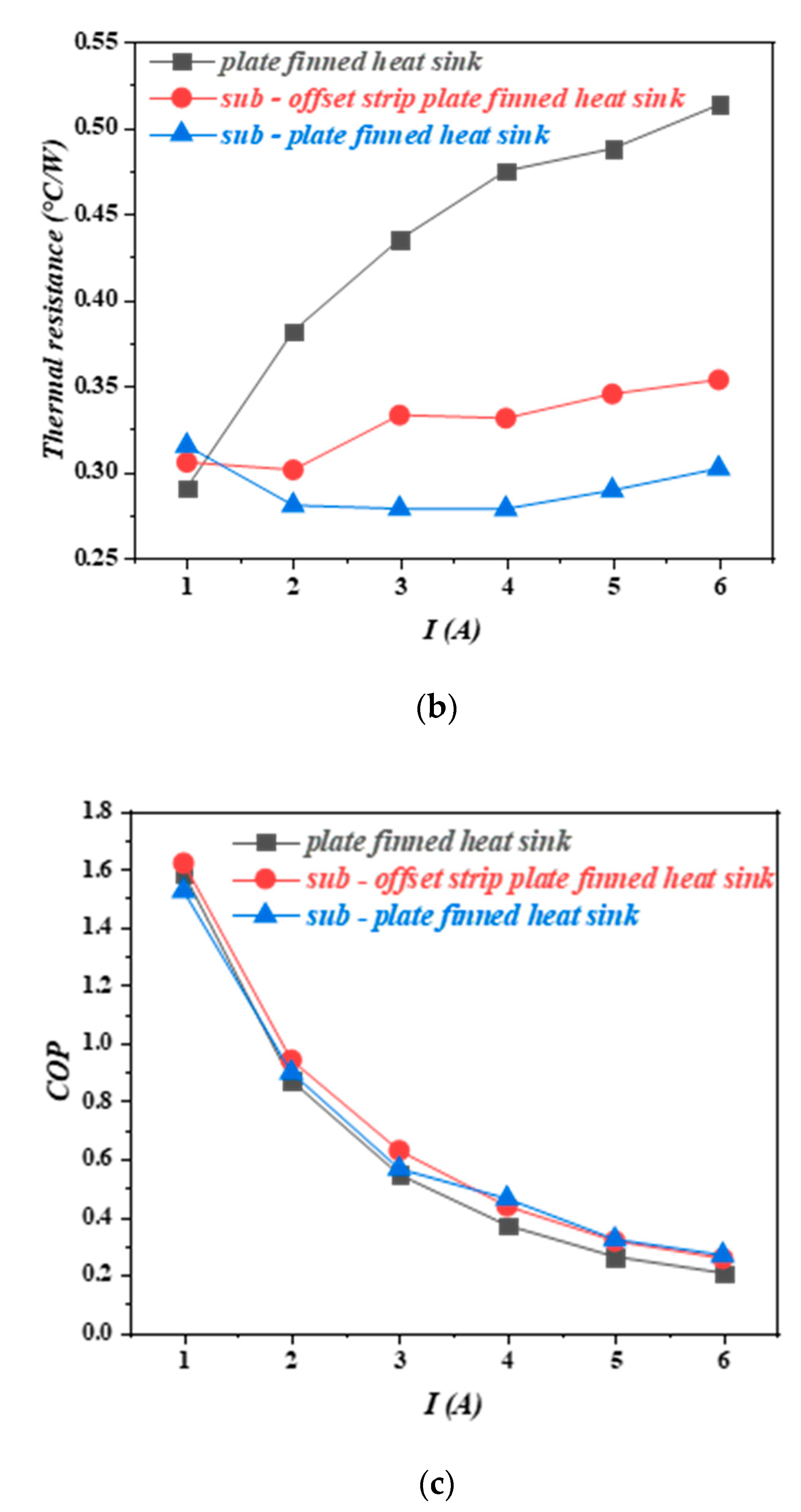
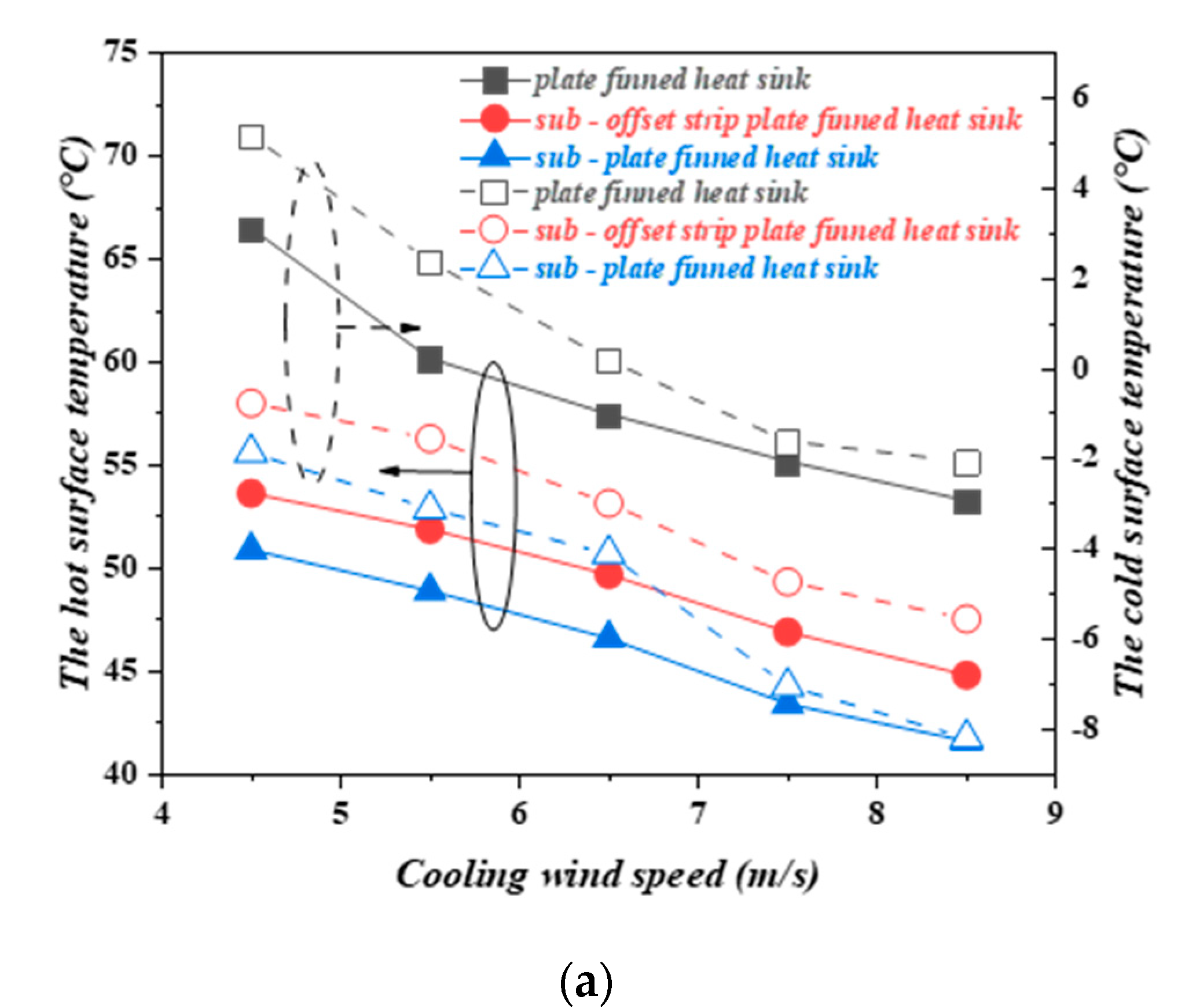
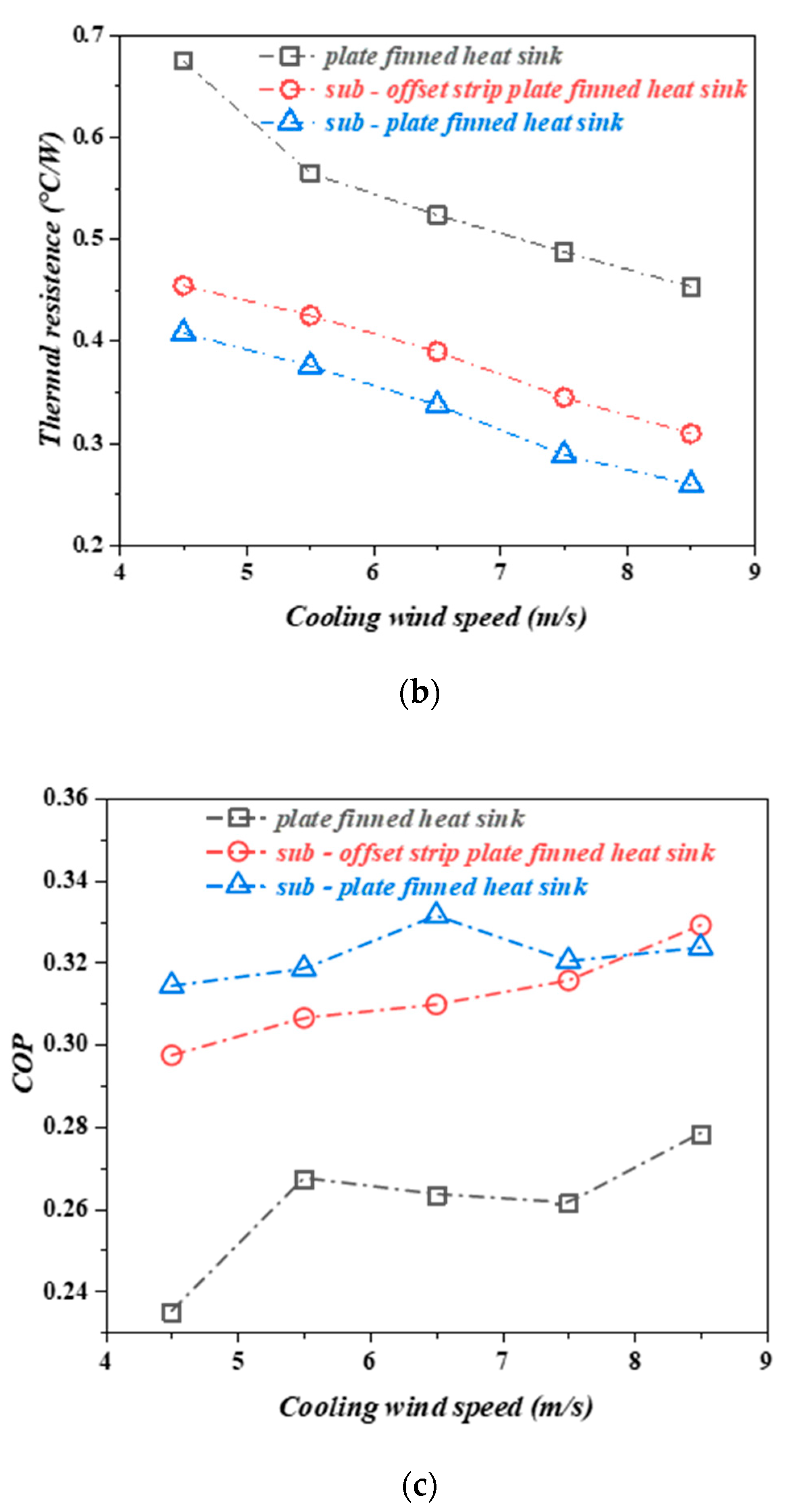
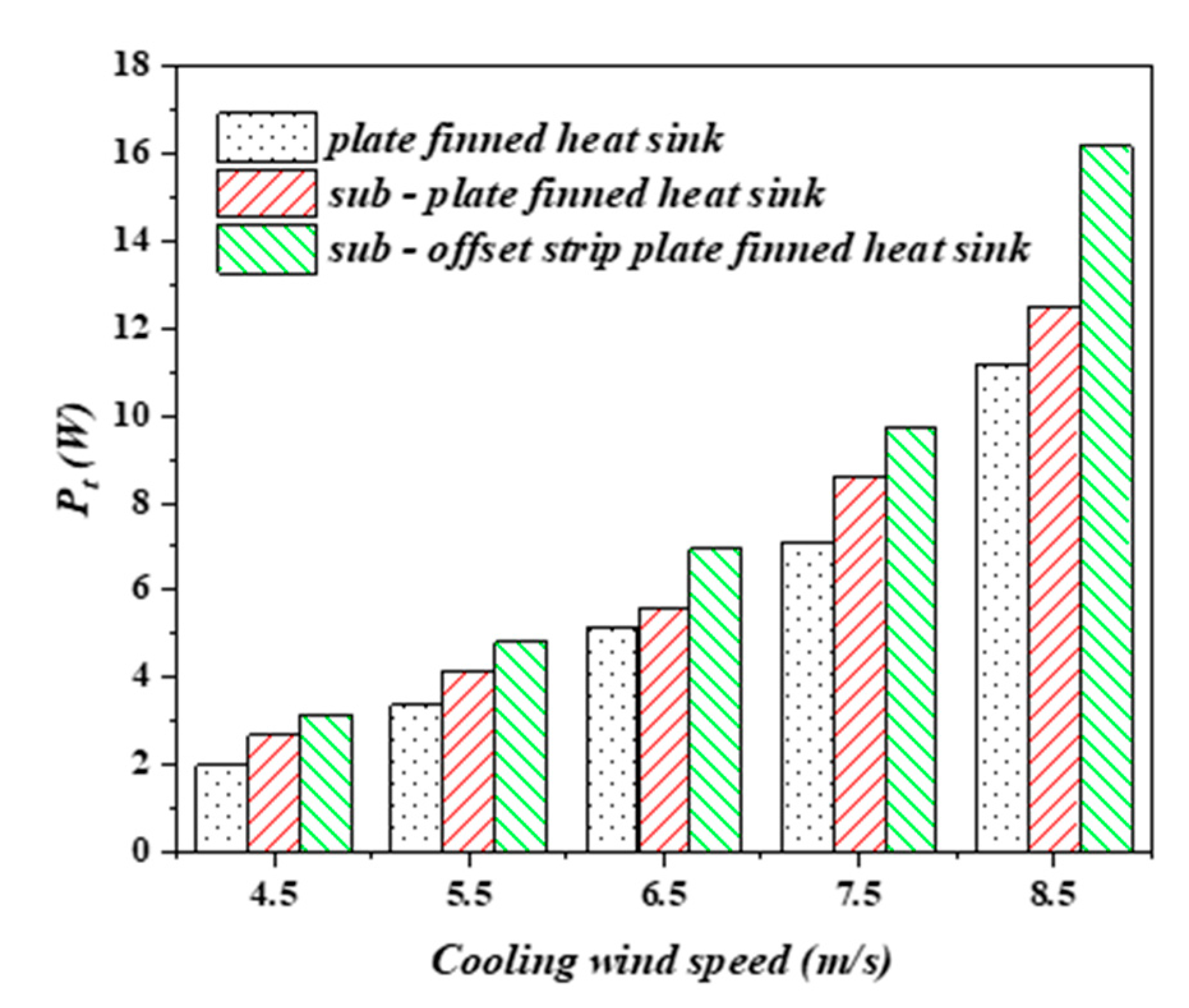
| Parameters | |||||
|---|---|---|---|---|---|
| Units | °C | A | V | °C | W |
| Values | 27 | 7.6 | 13.9 | 70.5 | 62.6 |
| Parameter | |||||||||
|---|---|---|---|---|---|---|---|---|---|
| Unit | mm | ||||||||
| Values | 2 | 4 | 3 | 1 | 5 | 40 | 2 | 1 | 1.5 |
| Name | Type | Accuracy | Resolution |
|---|---|---|---|
| DC supplier 1 | MS-3010D | ≤0.1% | 0.01 A |
| DC supplier 2 | HYX-1200E30 | ≤0.1% | 0.1 A |
| Anemometer | AC826 | ±3% | 0.001 m/s |
| Thermocouple | T | 0.1 °C | 0.01 °C |
| Display instrument | SIN-R5000C | 0.2% | 0.01 °C |
Publisher’s Note: MDPI stays neutral with regard to jurisdictional claims in published maps and institutional affiliations. |
© 2021 by the authors. Licensee MDPI, Basel, Switzerland. This article is an open access article distributed under the terms and conditions of the Creative Commons Attribution (CC BY) license (https://creativecommons.org/licenses/by/4.0/).
Share and Cite
Xia, G.; Zhao, H.; Zhang, J.; Yang, H.; Feng, B.; Zhang, Q.; Song, X. Study on Performance of the Thermoelectric Cooling Device with Novel Subchannel Finned Heat Sink. Energies 2022, 15, 145. https://doi.org/10.3390/en15010145
Xia G, Zhao H, Zhang J, Yang H, Feng B, Zhang Q, Song X. Study on Performance of the Thermoelectric Cooling Device with Novel Subchannel Finned Heat Sink. Energies. 2022; 15(1):145. https://doi.org/10.3390/en15010145
Chicago/Turabian StyleXia, Gaoju, Huadong Zhao, Jingshuang Zhang, Haonan Yang, Bo Feng, Qi Zhang, and Xiaohui Song. 2022. "Study on Performance of the Thermoelectric Cooling Device with Novel Subchannel Finned Heat Sink" Energies 15, no. 1: 145. https://doi.org/10.3390/en15010145
APA StyleXia, G., Zhao, H., Zhang, J., Yang, H., Feng, B., Zhang, Q., & Song, X. (2022). Study on Performance of the Thermoelectric Cooling Device with Novel Subchannel Finned Heat Sink. Energies, 15(1), 145. https://doi.org/10.3390/en15010145





